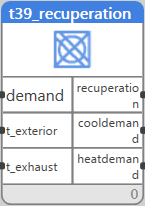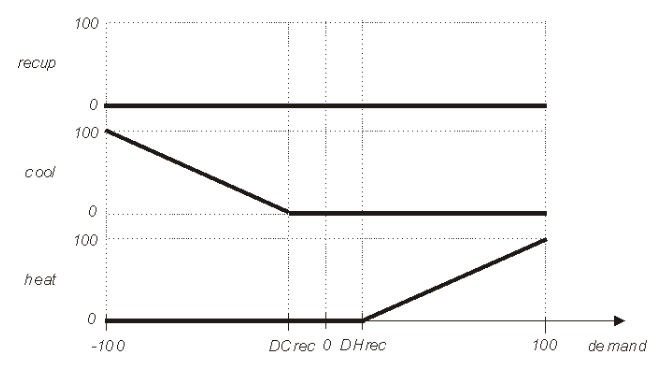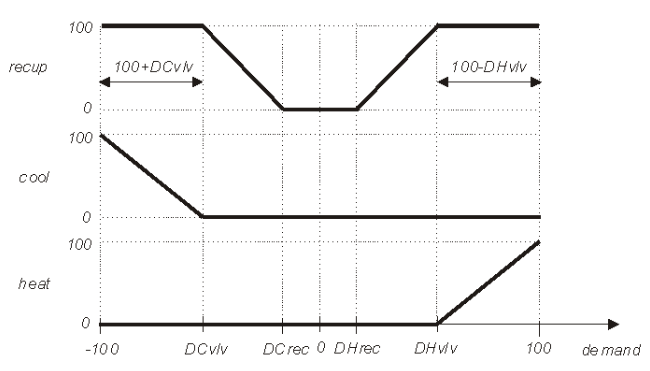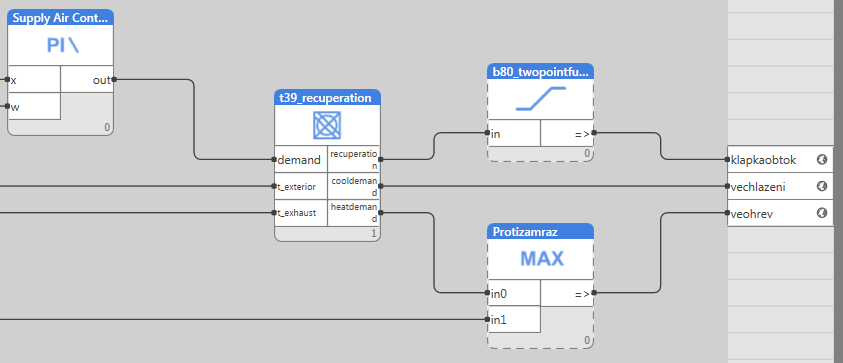Heat / Cool recovery
Block name
T39_RECUPERATION
ST call
PROGRAM TEST_T39 VAR X,Y,Z: REAL; O1,O2,O3: REAL; FB: LIB.HVAC.V1_0.T39_RECUPERATION; END_VAR FB(DEMAND:= X, T_EXTERIOR:= Y, T_EXHAUST:= Z); O1:= FB.HEATDEMAND; O2:= FB.COOLDEMAND; O3:= FB.RECUPERATION; END_PROGRAM
Library
LIB\HVAC
Version
V1.0
Description
The block is a decision and control element for heat (or cool) recovery strategy at an air handling unit with mixing dampers or heat recovery plate / wheel. Based on heating or cooling demands from an air supply temperature controller and outside (T_EXTERIOR) and exhaust (T_EXHAUST) temperatures, it generates three control sequences:
- heating sequence to control heating register valve
- cooling sequence to control cooling register valve
- heat recovery sequence to control the heat recovery wheel, mixing damper actuator, or plate exchanger bypass damper.
Inputs
| Input | Type | Description | Default value |
| DEMAND | REAL | Heating or cooling demand, -100 (cooling) …100 (heating) (%) | 0 |
| T_EXTERIOR | REAL | AHU inlet temperature, or outside air temperature (°C) | 0 |
| T_EXHAUST | REAL | AHU extract temperature, or room temperature (°C) | 0 |
| DCREC | REAL | Cooling demand to start recovery (creates dead band), typically -5 (%) | -5 |
| DCVLV | REAL | Cooling demand to start cooling sequence, 0…100 (%) | -10 |
| DHREC | REAL | Heating demand to start recovery (creates dead band), typically 5 (%) | 50 |
| DHVLV | REAL | Heating demand to start heating sequence, 0…100 (%) | 70 |
Outputs
| Output | Type | Description |
| RECUPERATION | REAL | Signal for the heat/cool recovery actuator, 0…100 (%) |
| COOLDEMAND | REAL | Cooling valve signal, 0…100 (%) |
| HEATDEMAND | REAL | Heating valve signal, 0…100 (%) |
| COOLRECREADY | BOOL | Signal that the decision logic is ready to recuperate cooling energy (see point 4 below) |
| HEATRECREADY | BOOL | Signal that the decision logic is ready to recuperate heating energy (see point 2 below) |
Function
The DEMAND signal must be set so as to change from 0 to 100 % when the AHU has to heat, and 0…-100 % for the cooling operation. The signal source is usually a supply air PI controller.
The insensitivity parameters, DCREC and DHREC, specify at which DEMAND signal the heat recovery shall be started. They prevent from operating the heat recovery aggregate at low demand levels.
The internal block logic specifies which of the four situations below is active:
- There is a heating demand (or, DEMAND > DHREC), the outside temperature is higher than the exhaust temperature. Heat recovery makes no sense, as it is more useful to heat the warmer outside air.
- There is a heating demand, the outside temperature is lower than the exhaust temperature. Heat recovery makes sense as the extract air energy can be used to preheat the cold outside air.
- There is a cooling demand (or, DEMAND < DCREC), the outside temperature is lower than the exhaust temperature. Recovery makes no sense, it is more useful to bring the cold outside air in (the room shows high thermal gains because of high occupancy, lighting or technology installed etc.).
- There is a cooling demand, the outside temperature is higher than the extract air temperature. It is worth to recover because the cooling energy of the extract air can be used to precool the outside air.
At situations 1 and 3, the heating and cooling outputs (HEATDEMAND a COOLDEMAND) behave in the same way as if they were connected directly to the supply air controller output (with the corresponding cooling sequence recalculation, i.e. 0 % - cooling valve fully closed, -100 % - cooling valve fully open). The RECUP output is permanently at 0.
At situations 2 and 4 first of all the heat recovery sequence is activated, and if the energy demand still increases (as given by the PI algorithm of the supply air controller), the heating or cooling valve opens. The parameters DCVLV and DHVLV specify the energy contributions of heat recovery process and direct heating / cooling: the more the heat recovery system power is against the heating or cooling register maximum power, the higher the parameter values should be.
The valve sequences 0…100 % are recalculated between DCVLV (or DHVLV) and -100 % (or 100 %), see figure below.



